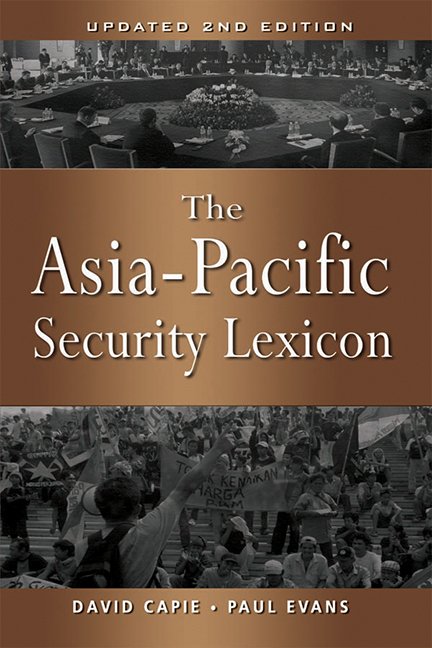Book contents
- Frontmatter
- Contents
- Abbreviations
- Introduction to the Second Edition
- Ad Hoc Multilateralism
- A la Carte Multilateralism
- The “ASEAN Way”
- Balance of Power
- Bilateralism
- Coalition of the Willing
- Coercive Diplomacy
- Collective Defence
- Collective Security
- Common Security
- Comprehensive Security
- Concert of Powers
- Concerted Unilateralism
- Confidence-Building Measures
- Confidence- and Security-Building Measures
- Constructive Intervention
- Cooperative Security
- Engagement
- Flexible Consensus
- Human Security
- Humanitarian Intervention
- Middle Power
- Multilateralism
- Mutual Security
- New Security Approach
- Non-Traditional Security
- Open Regionalism
- Peaceful Rise
- Pre-emption and Preventive War
- Preventive Diplomacy
- Security Community
- Terrorism
- Track One
- Track One-and-a-Half
- Track Two
- Track Three
- Transparency
- Trust-Building Measures
- About the Authors
Cooperative Security
Published online by Cambridge University Press: 21 October 2015
- Frontmatter
- Contents
- Abbreviations
- Introduction to the Second Edition
- Ad Hoc Multilateralism
- A la Carte Multilateralism
- The “ASEAN Way”
- Balance of Power
- Bilateralism
- Coalition of the Willing
- Coercive Diplomacy
- Collective Defence
- Collective Security
- Common Security
- Comprehensive Security
- Concert of Powers
- Concerted Unilateralism
- Confidence-Building Measures
- Confidence- and Security-Building Measures
- Constructive Intervention
- Cooperative Security
- Engagement
- Flexible Consensus
- Human Security
- Humanitarian Intervention
- Middle Power
- Multilateralism
- Mutual Security
- New Security Approach
- Non-Traditional Security
- Open Regionalism
- Peaceful Rise
- Pre-emption and Preventive War
- Preventive Diplomacy
- Security Community
- Terrorism
- Track One
- Track One-and-a-Half
- Track Two
- Track Three
- Transparency
- Trust-Building Measures
- About the Authors
Summary
Of the security concepts in use in Asia-Pacific security discourse, this is one of the most popular and ambiguous. While the origins of the concept are unclear and the term is used in very different ways around the region, this has not stopped numerous scholars and various government officials from claiming to have coined or “introduced” the concept. An early reference to cooperative security in the Asia-Pacific region appeared in the title of the 1988 Pacific Basin Symposium. It used the term as more or less synonymous with security cooperation.
In a 1988 article, John Steinbruner offered a more substantive discussion of the concept. He consciously used the term cooperative security to differentiate it from common security. His article focuses on the need to create strategic stability between the Soviet Union and the United States, and looks almost exclusively at Europe. It does not shed much light on cooperative security as a concept, but instead prescribes security policies to promote stability. The most important of these include the adoption of essentially defensive military postures. Steinbruner claims that the United States has “long promoted abstract ideas of cooperative security” although he provides no specific examples. He went on to develop his ideas in a series of workshops and a conference with other leading American academics and senior officials (see below), leading to the publication of the monograph, A New Concept of Cooperative Security, in 1992. Yet cooperative security was not immediately picked up by Asia-Pacific scholars in the United States.
Instead, it was a Canadian Government-sponsored project, the North Pacific Cooperative Security Dialogue (NPCSD) which made most of the early running developing the substance of the concept. The NPCSD, which ran from 1990 until 1993, was one of the first “Track Two” unofficial security dialogues in the region. It brought together scholars and officials from across the Asia- Pacific to discuss a wide range of traditional and non-conventional security issues.
- Type
- Chapter
- Information
- The Asia-Pacific Security Lexicon (Upated 2nd Edition) , pp. 105 - 114Publisher: ISEAS–Yusof Ishak InstitutePrint publication year: 2007

